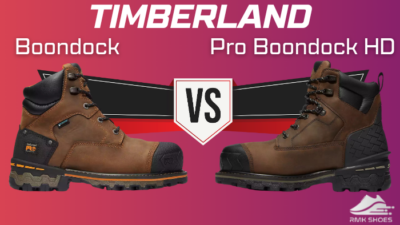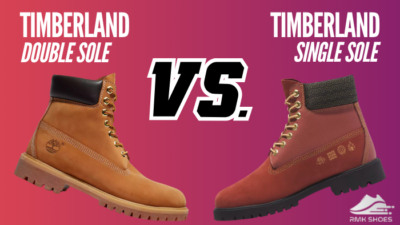I was pretty happy with HOKA Bondi 8 for my daily running sessions, except for issues with overpronation.
So you can imagine how excited I was when Asics dropped their Nimbus 25 runner, which promised to overtake Bondi 8 in stability without sacrificing comfort.
I quickly bought a pair and put them against my existing Hoka shoes to test their claim.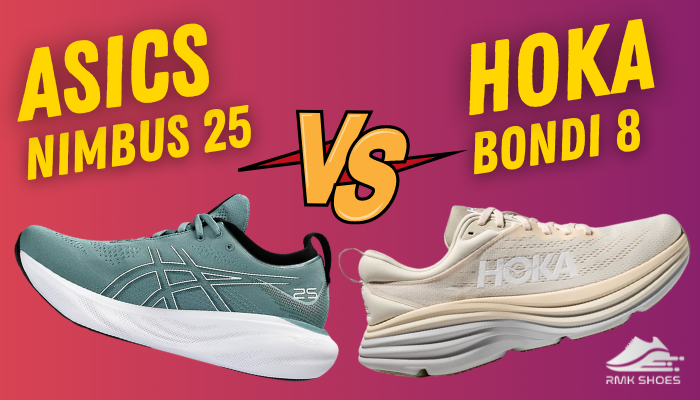
Let’s discuss the notable differences I have found between the Nimbus 25 and Bondi 8 after running with these shoes for the past few months.
A Quick Rundown of Asics Nimbus 25 and Hoka Bondi 8
Both Hoka and Asics offer excellent running shoes that can satisfy even the most professional athletes. The Nimbus 25 from Asics and Bondi 8 from Hoka are no different.
The Asics Nimbus 25 is the latest offering from the Nimbus lineup, which specializes in providing plush comfort and lightweight stability. With these shoes, you can expect a luxurious and smooth ride for longer distances.
As this model is the latest iteration from Asics, it also has the latest and greatest innovation that Asics has to offer.
Meanwhile, maximum cushioning takes center stage for the Hoka Bondi 8.
Despite focusing on comfort, it also aims to conquer any terrain or distance, thanks to its supportive cradle and meta-rocker midsole.
As a flagship model, this pair epitomizes the brand’s philosophy: run farther, feel lighter.
Feature Comparison Between Asics Nimbus 25 and Hoka Bondi 8
The ASICS Nimbus 25 and HOKA Bondi 8 might be dedicated to the running crowd, but they rely on their in-house technologies to achieve this goal.
As a result, these shoes have quite a few technical differences.
| Attributes | ASICS Nimbus 25 | HOKA Bondi 8 |
|---|---|---|
| Release year | 2023 | 2022 |
| Weight | 10.5oz(for Men’s US 9.5 size) | 11.4oz(for Men’s US 9.5 size) |
| Sizing | True to size | True to size, wide or extra-wide options are available |
| Upper material | Engineered mesh with recycled materials | Engineered mesh with recycled materials |
| Insole | Removable ORTHOLITE X-55 sockliner | Removable OrthoLite footbed |
| Midsole | Flytefoam Blast Eco Plus, GEL units | CMEVA foam with Meta-Rocker technology |
| Cushioning | Plush and responsive, good energy return | Maximal and pillowy, good shock absorption |
| Outsole | AHAR(Asics High Abrasion Rubber) | Durable rubber overlays |
| Stack height | 33.5-41.5mm | 35-39mm |
| Heel drop | 8mm | 4mm |
| Stability | Excellent with Guidance Trusstic technology | Moderate |
| Price range | Around $160 | $130-$165 |
These technical variances between these runners often deliver a distinctly different running experience, which we will discuss below.
Major Differences Between Asics Nimbus 25 and Hoka Bondi 8
From the material technology to the overall build of these shoes, there are many aspects that set the Nimbus 25 apart from the Bondi 8. These differences can greatly help any potential buyer to make a sound purchase decision.
So, check out these key differences between Asics Nimbus 25 and Hoka Bondi 8 to pick the right one for you.
1. Upper Construction
When we put these shoes side-by-side, the most notable difference between them that stands out right away is the upper construction.
Let me elaborate.
Design Language
The Gel-Nimbus 25 retains a classic silhouette with a familiar running profile. It’s no different than other traditional running shoes from ASICS.
It has subtle design elements, like reflective accents and embossed graphics, to add a touch of sophistication without screaming for attention. The preferred colorways of this pair are also very muted.
As a result, you can style them with any casual wear and get a stylish outfit out of it.
You can still find some branding for Asics’ proprietary technologies, like PureGEL on the foxing or FF Blast on the midsole.
On the flip side, the Bondi 8 has a bold look with prominent branding.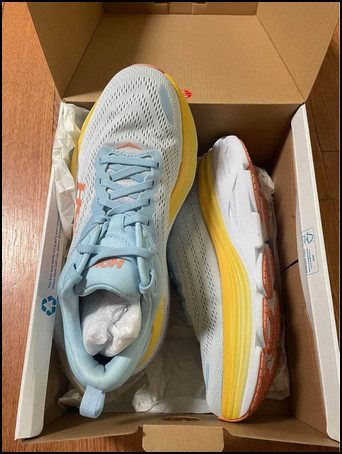
It proudly showcases a chunky, oversized midsole to make a fashion statement.
Hoka takes a completely different approach compared to the Asics by going with a vibrant and eye-catching build that screams performance.
You’ll also get a handful of contrasting color combinations to choose from, like neon greens, vibrant yellows, or contrasting black and white options.
Upper Material
Both shoes utilize engineered knit mesh made from recycled material. But there are some underlying variances that end up providing a slightly different feel.
For example, the Nimbus has FluidFit technology that ensures a personalized feel. The upper build will mold around your foot to provide a snug fit regardless of your foot shape.
It also has decent flexibility and reinforced areas to improve durability.
The downside?
It’s not as breathable as the Bondi 8’s upper, which has open ventilation zones for enhanced breathability.
But it takes a hit in durability as it has less structure and support compared to the Nimbus 25.
Tongue
The Hoka Bondi 8 has a thicker tongue that integrates seamlessly with the upper.
As the tongue lays flat, it allows for more freedom of movement, extra comfort, and plush padding for pressure relief.
The Nimbus opted for a gusseted tongue with more focus on breathability than comfort.
However, its moderate thickness offers a balance of comfort and flexibility without adding too much bulk to the overall feel of these shoes.
Whether you want comfort or breathability entirely depends on your preferences and running style. As each of these shoes excels in their own way, pick whichever serves your purpose. You can’t go wrong with either of these shoes.
2. Midsole and Comfort
Asics Gel-Nimbus 25 utilizes a combination of FF Blast Eco Plus, a lightweight and responsive foam, and A6 Gel, the brand’s softest gel yet. Such a layered cushioning system absorbs shock effectively while offering ground feedback and a touch of bounce.
However, it’s not as bouncy as some maximalist shoes like the Hoka Bondi 8.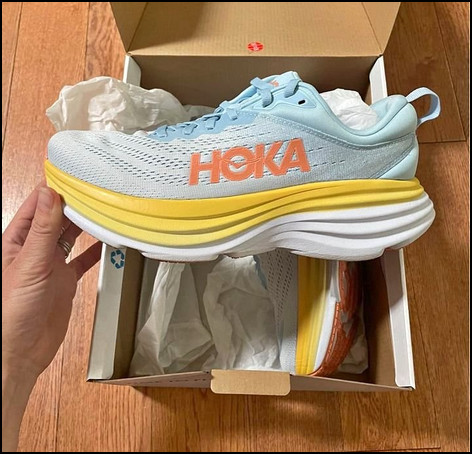
This foam also contributes a lot to the overall lightweight feel of the Nimbus runner, but more on that later.
Overall, it’s a great running shoe if you prioritize stability but don’t want to sacrifice comfort for long sessions.
Switching over to the Hoka Bondi, it has a CMEVA midsole, which is a lighter version of the traditional EVA foam. This kind of foam is well-known for its marshmallow-like feel and ample cushioning.
Hence, it’s ideal for runners seeking a smooth, effortless ride.
But the softer feel and the lack of responsiveness(compared to the Nimbus) are not suitable for fast-paced running or overpronation.
Overall, the Gel-Nimbus 25 from ASICS has a better balance in comfort and stability of its midsole offering.
3. Outsole and Durability
The Hoka Bondi 8 incorporates rubber overlays on its outsole with an exposed CMEVA midsole. The zonal rubber placement with tread patterns helps reduce the weight of the shoe without sacrificing surface grip.
But the durability takes a hit!
I started noticing early signs of wear and tear after a few long runs.
Thankfully, Asics has implemented their in-house AHAR(Asics High Abrasion Rubber) outsole in Gel-Nimbus 25 that provides excellent traction and durability.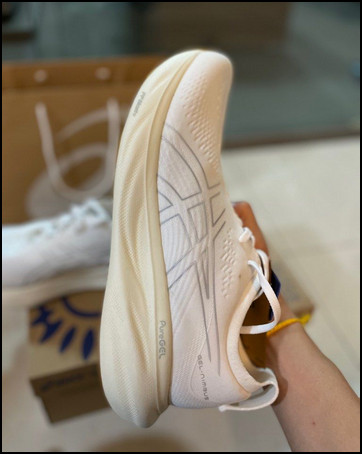
Similar to Bondi, it also has strategically placed rubber overlays for added flexibility.
Despite having such similarities, Gel-Nimbus takes the upper hand in durability as Asics has placed dense rubber in high-wear zones, like the heel or forefoot.
4. Fit and Sizing
Both Asics Nimbus and Hoka Bondi shoes mostly run true to size, with options for half-sizes.
If you go for the Bondi 8, you’ll get wide and extra-wide options for wider foot support. The Gel-Nimbus is only available in the standard profile.
Furthermore, the Gel-Nimbus also has a snug-fit upper which may seem tight for high-volume feet.
Not to mention, even the standard HOKA Bondi 8 has a wider profile compared to the Nimbus 25, making it more suitable for wider foot shapes.
And that’s not all!
Toe Cap
The Bondi 8 features a roomy upper with ample toe box space for a relaxed fit. Its taller profile also provides enough space for toe-wiggling.
On the other hand, the Nimbus 25 boasts a standard, rounded toe cap to accommodate most foot shapes.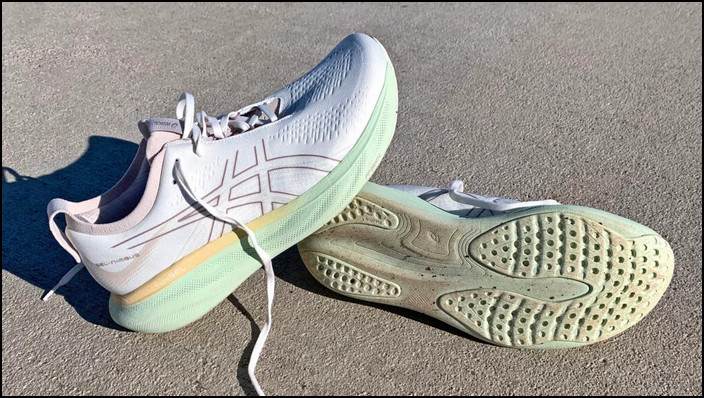
However, you might need to go half a size up if you want to avoid bunions or blistering.
Lacing
Both shoes have a traditional lacing system and pull strap in the heel tab to get your desired snug fit.
The standard profile tongues of these runners also prevent any kind of lace bites while running.
Additionally, the Hoka Bondi has 6 eyelets with reinforced overlays, while the Nimbus 25 has 5 eyelets with knitted loops.
Both have extra eyelets for heel lock lace, but I never felt the need to utilize that one. The standard fit is more than enough for any high-movement activities.
Collar
The Asics Nimbus 25 features a well-padded collar that wraps snugly around your heel and provides a locked-in feel. This additional reinforcement further enhances the heel hold and prevents any unwanted slippage during fast-paced running.
Conversely, the Bondi prioritizes comfort and offers more padding around the heel to increase ankle support.
It also has a relaxed feel and a less constricting fit for better foot movement.
However, it sorely lacked the heel lockdown feel that I got from the Asics shoes.
For a running shoe, adequate comfort and a secure fit are must-have features, which are more readily present in the Nimbus 25 compared to the Bondi 8.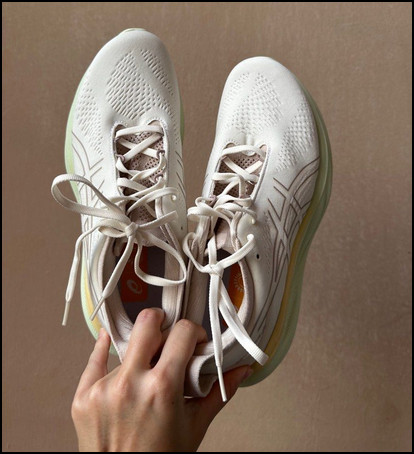
5. Weight Distribution
Despite having a higher heel height(41.5mm) in Nimbus 25, the Gel units contribute a lot to better weight distribution.
Not to mention, the higher offset(8mm) promotes heel strike running style to distribute your weight towards the rear foot. It adds comfort and stability to each of your strides and allows a more natural footstrike for overpronators.
As the Hoka Bondi 8 has a lower heel drop, it encourages a midfoot or forefoot strike, spreading your weight more evenly across the shoe.
Hence, the weight distribution of the Hoka Bondi 8 is more suitable for neutral runners and those with either fast or slow running styles. But for overpronators, the Nimbus 25 is the best bet.
6. Running Performance
Both shoes offer sufficient cushioning and stability for various strike patterns.
For example, the FF Blast foam of the Nimbus 25 offers adequate bounce and responsiveness, despite having a firmer feel than the Bondi 8.
It effectively prevents any fatigue from midfoot strike running style, even for longer sessions.
And it keeps getting better!
The strategically placed Gel units propel your forward movement to gain speed without losing stability, thanks to the embedded plastic shank that runs under the arch(Guidance Trusstic). Such a trait is sorely missing in the Hoka’s offering.
Speaking of Hoka, its lower heel drop is perfect for flat feet runners as the curved foam frame cradles your feet. It also allows a smooth rolling motion to aid your transitions.
The Bondi 8 also has a reinforced heel counter for extra support, which can come in handy if you want to take your running sessions on rougher terrain.
However, the Gel-Nimbus 25 seems to be a better fit for versatile running styles as it has better stability for high-performance runners.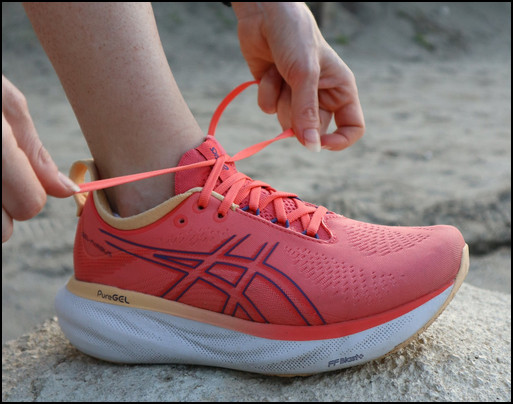
7. Walking and All-Day Wear
The curved sole shape(Meta-Rocker design) of the Bondi 8 gives a rocking motion from heel to toe to get that perfect midfoot strike through every gait cycle.
This improves the daily walking experience a lot, especially if you are looking for maximum comfort or all-day training. The breathable vamp also provides confidence for everyday wear.
So you don’t have to worry about foot fatigue or blistering at all.
The Nimbus shoes are also more than enough for a satisfying walking experience, as FF Blast Eco Plus foam and Gel units provide a bouncy ride.
It is also around 1 ounce lighter than Hoka, which is great for those who want a lightweight feel from their casual wear.
That being said, it’s not as comfortable as the Bondi 8.
Overall, the Hoka Bondi 8 is a better deal for any potential buyers who want a robust everyday walking shoe.
8. Price to Value Proposition
As the Bondi 8 is a one-year older shoe, you can find it on the market for around $130 to $165 with readily available discounts.
Meanwhile, the Nimbus 25 is mostly available for around $160, with less chance of getting any promo codes.
If you compare them at MSRP, the Asics offers a better value proposition than Hoka.
However, it’s a better deal if you can get your hands on the Bondi 8 for around $130 or less.
Strengths and Weaknesses of the Hoka Bondi 8 and Asics Nimbus 25
Since the Bondi 8 and Nimbus 25 target different running crowds, each has advantages and disadvantages.
The below-listed pros and cons of the Hoka Bondi 8 and Asics Nimbus 25 should provide a better understanding in this regard.
HOKA Bondi 8
- »Adequate cushioning for recovery or long runs.
- »Smoother transitions.
- »Wider platform for natural footstrike.
- »Secure fit for wider foot shapes.
- »Decent weight balance.
- »Less stability for overpronators.
- »Heavier and bulky feel.
ASICS Nimbus 25
- »Lighter feel during long runs.
- »Good energy returns for a responsive ride.
- »Moderate stability.
- »Breathable upper.
- »Durable outsole.
- »The cushioning could be better.
- »Less rockered geometry.
Asics Nimbus 25 Vs Hoka Bondi 8: Which Is the Best For You?
The Asics Nimbus 25 is a better running shoe overall compared to the Hoka Bondi 8, as it caters to both neutral and stability runners. It not only offers a more stable platform for overpronators, but it also has excellent fit, adequate cushioning, and satisfying strides.
However, the Bondi 8 from Hoka will be more suitable for those who want uncompromised comfort and have wider forefeet.
Nonetheless, the GEL-Nimbus 25 is easier to recommend for most runners due to having a decent balance between comfort and stability, which is more important for high-performance sessions.
Frequently Asked Questions
Are Hokas or ASICS better for running?
Generally, HOKA shoes are better for running as they have maximal cushioning and excellent shock absorption. The ASICS shoes are suitable for overpronators.
What is HOKA Bondi 8 best for?
The Bondi 8 from Hoka is best known for its wider platform and meta-rocker technology. It also has adequate cushioning for heavy or high-mileage runners.
Which shoe is the Nimbus 25 equivalent from HOKA?
The Bondi 8 is currently the Nimbus 25 equivalent from Hoka. These two pairs might not have any strong similarities, but they come closest regarding their intended purpose and focus on comfort.

